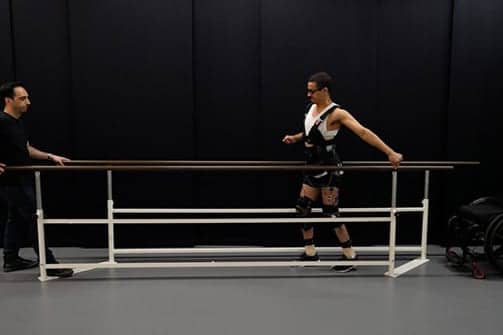
STIMO study participant David Mzee–a paraplegic as the result of a sports accident–is shown here taking a few steps of his own. (Photo courtesy of PFL / Jean-Baptiste Mignardot)
Three patients with chronic paraplegia were reportedly able to walk over ground thanks to precise electrical stimulation of their spinal cords via a wireless implant. A study from Ecole Polytechnique Fédérale de Lausanne in Switzerland details the research.
After a few months of training, the patients were able to control previously paralyzed leg muscles even in the absence of electrical stimulation, according to the scientists.
The study, called STIMO (STImulation Movement Overground), establishes a new therapeutic framework to improve recovery from spinal cord injury. All patients involved in the study recovered voluntary control of leg muscles that had been paralyzed for many years.
The STIMO study, led by the Ecole Polytechnique Fédérale de Lausanne (EPFL) and the Lausanne University Hospital (CHUV) in Switzerland, was published recently in Nature and Nature Neuroscience.
“Our findings are based on a deep understanding of the underlying mechanisms which we gained through years of research on animal models. We were thus able to mimic in real time how the brain naturally activates the spinal cord,” says EPFL neuroscientist Grégoire Courtine, in a media release from Ecole Polytechnique Fédérale de Lausanne.
“All the patients could walk using body weight support within one week. I knew immediately that we were on the right path,” adds CHUV neurosurgeon Jocelyne Bloch, who surgically placed the implants in the patients.
“The exact timing and location of the electrical stimulation are crucial to a patient’s ability to produce an intended movement. It is also this spatiotemporal coincidence that triggers the growth of new nerve connections,” says Courtine.
“The targeted stimulation must be as precise as a Swiss watch. In our method, we implant an array of electrodes over the spinal cord which allows us to target individual muscle groups in the legs,” Bloch explains. “Selected configurations of electrodes are activating specific regions of the spinal cord, mimicking the signals that the brain would deliver to produce walking.”
The challenge for the patients was to learn how to coordinate their brains’ intention to walk with the targeted electrical stimulation. But that did not take long, the release continues.
“All three study participants were able to walk with body-weight support after only 1 week of calibration, and voluntary muscle control improved tremendously within 5 months of training,” Courtine shares. “The human nervous system responded even more profoundly to the treatment than we expected.”
During rehabilitation sessions, the three participants were able to walk hands-free over more than one kilometer with the help of targeted electrical stimulation and an intelligent body weight-support system. Moreover, they exhibited no leg-muscle fatigue, so there was no deterioration in stepping quality. These longer, high-intensity training sessions proved crucial for triggering activity-dependent plasticity—the nervous system’s intrinsic ability to reorganize nerve fibers—which leads to improved motor function even when the electrical stimulation is turned off, per the release.
[Source(s): Ecole Polytechnique Fédérale de Lausanne, Science Daily]




